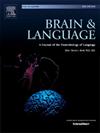The impact of linguistic complexity on feasibility and reliability of language mapping in aphasic glioma patients
IF 2.3
2区 心理学
Q1 AUDIOLOGY & SPEECH-LANGUAGE PATHOLOGY
引用次数: 0
Abstract
Background
Reliable language mappings require sufficient language skills. This study evaluated whether linguistic task properties impact feasibility and reliability of navigated transcranial magnetic stimulation (nTMS)-based language mappings in aphasic glioma patients.
Methods
The effect of linguistic complexity on naming accuracy during baseline testing without stimulation and on the number of errors during nTMS was evaluated for 16 moderately and 4 severely expressive aphasic patients.
Result
During baseline, items acquired later in life and used less frequently, a higher amount of multisyllabic, compound, and inanimate items were named inaccurately. Even after removing these more complex items, less frequent and multisyllabic items were more error-prone during stimulation.
Conclusion
Higher linguistic item complexity was associated with decreased naming accuracy during baseline and resulted in a potentially higher false positive rate during nTMS in aphasic glioma patients. Thus, tailoring task complexity to individual performance capabilities may considerably support the preservation of residual functionality.
语言复杂性对失语胶质瘤患者语言定位可行性和可靠性的影响。
背景:可靠的语言映射需要足够的语言技能。本研究评估了语言任务特性是否会影响失语胶质瘤患者导航经颅磁刺激(nTMS)语言映射的可行性和可靠性。方法:对16例中度和4例重度表达性失语症患者进行无刺激基线测试时语言复杂性对命名正确率和nTMS时错误数的影响进行评估。结果:在基线阶段,获得较晚且使用频率较低的项目,多音节、复合和无生命项目的命名不准确率较高。即使在移除这些更复杂的项目后,在刺激过程中,频率较低和多音节的项目更容易出错。结论:较高的语言项目复杂性与基线时命名准确性降低有关,并导致失语胶质瘤患者在nTMS期间潜在的更高假阳性率。因此,将任务复杂性调整为单个性能可能会在很大程度上支持保留剩余功能。
本文章由计算机程序翻译,如有差异,请以英文原文为准。
求助全文
约1分钟内获得全文
求助全文
来源期刊

Brain and Language
医学-神经科学
CiteScore
4.50
自引率
8.00%
发文量
82
审稿时长
20.5 weeks
期刊介绍:
An interdisciplinary journal, Brain and Language publishes articles that elucidate the complex relationships among language, brain, and behavior. The journal covers the large variety of modern techniques in cognitive neuroscience, including functional and structural brain imaging, electrophysiology, cellular and molecular neurobiology, genetics, lesion-based approaches, and computational modeling. All articles must relate to human language and be relevant to the understanding of its neurobiological and neurocognitive bases. Published articles in the journal are expected to have significant theoretical novelty and/or practical implications, and use perspectives and methods from psychology, linguistics, and neuroscience along with brain data and brain measures.
 求助内容:
求助内容: 应助结果提醒方式:
应助结果提醒方式:


